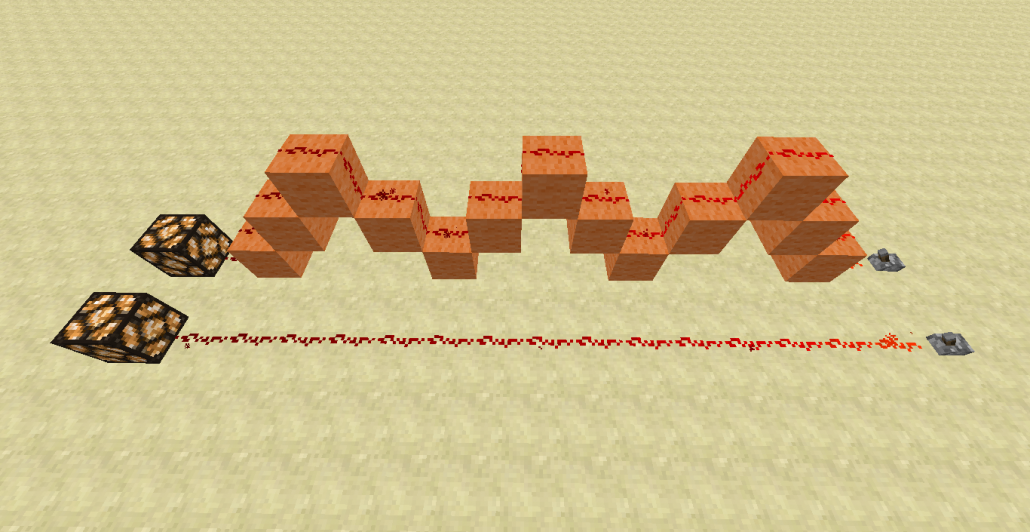Wiring
Redstone dust is the flat block you see when you place the redstone item on the ground. This is the most basic component of any circuit you will make – wiring. The dust has many aspect variants, according to the blocks beside it:
- If there is only one wire and nothing else, it will look circular.
- If there is a power source directly adjacent to a wire, it will visibly connect to that power source.
- If two wires are placed adjacent to each other, they will visibly connect to each other.
- The intersection of two wires looks like a plus symbol and does not isolate the wires. In other words, to cross two wires you must change the elevation of one of them and make sure they do not connect.
Power will travel in a line for 15 blocks, starting on the block directly adjacent to the power source. These 15 blocks are calculated using taxicab geometry – that is, the distance is calculated using the sum of the absolute differences of the Cartesian coordinates of blocks. In simpler terms, this means that regardless of whether the elevation changes or whether the wire spirals around the power source, after 15 redstone wire blocks the signal strength of that wire will reach 0.
If you place an opaque block with redstone wire running into it, when that wire is on the block will be powered. However, any redstone wire coming out of it will be off. Redstone signal will not transmit through a block without the use of repeaters. We will talk a bit more about the difference between weak and strong power in the interactions section.
Try making the wires in the image above in your Minecraft world. In the top line, when you place a block above the wire in one of the valleys, the signal does not travel through – however, in the second line the signal is unaffected. In general, opaque blocks overhead in situations like a gap between two blocks and redstone on the block below will stop the signal.
Note only opaque blocks can be powered. However, if redstone can be placed on a transparent block (you can place wire on glowstone but not on glass, for example) it will transmit redstone power upwards but not downwards (a simple diode).
Horizontal vs Vertical
- Horizontal wiring occurs when the Y coordinate of the all redstone dust blocks of which it is composed is the same. It is very straightforward to create – just place wire in a line until the power runs out. A strongly powered block on the same level as the wire still counts as horizontal.
- Vertical wiring occurs when the elevation of the wire is changed. There are many ways to connect two components separated on the Y coordinate:
- The simplest way is via a spiral staircase of blocks with redstone dust on top reaching to wherever the target is. This design is horizontally stackable – that is, you can put two staircases in opposite orientations adjacent to each other and no wires from one will connect to the other. It is also the only one on this list that transmits power upwards and downwards and as thus is the most common variant of vertical wiring.
- If you want power to transmit only upwards, you can use:
- a sequence of transparent blocks such as half slabs or glowstone, placed in a zigzag pattern upwards with redstone dust on top. They will act as diodes, letting the signal go just one way (upwards). Note you cannot stack these columns horizontally – you will need to leave a one block gap between them.
- a torch tower, that is, a 1-block-wide vertical sequence consisting of block, redstone torch, block, redstone torch, etc. The main advantage of this design is that it is fully stackable and you can place vertical lines directly adjacent to each other without worrying about interaction. The mechanic underlying torch towers is sequential NOT gates, which will be explained later on.
- If you want power to transmit only downwards, you may use piston chains. They are also just 1 block wide and consist of sticky pistons pointing downwards with a redstone block attached, the piston above powering the piston below, which in turn extends and powers the next piston down. The main advantage of this design, apart from the reduced column area, is the fact that falling edges (which happen when you turn the power off) take no time to reach the bottom, i.e. you can make something happen from sky limit to bedrock instantly. This makes use of the zero-tick mechanic, detailed in a later post.


